India/Hindi Language and Culture Kit
A is for Anaar: My First Hindi Alphabet Book. Hatti, Aruna. Ganapathy, Kalyani, Ill. Gnaana Publishing, 2015. ISBN: 9781943018222.
This book takes readers on a journey through the Hindi alphabet, and explores India’s culture, geography, history, and foods. Included are prompts for beginning Hindi conversation, a Hindi alphabet chart and pronunciation guide, and a glossary of Hindi words and phrases. Hindi text is translated into English.
Aani and the Tree Huggers. Atkins, Jeannine. Pinto, Venantius J., Ill. Lee and Low Books, 2000. ISBN: 9781584300045.
This historical fiction story is based on real events in the 1970’s during the Chipko Andolan (“Hug the Tree Movement”). In the story, Aani and a group of village women in Northern India stand up to loggers by hugging the trees. This successful movement has led to councils today meeting within most villages to decide how many trees can be cut without endangering the land. It is important to note that the illustrations were inspired by 17th century styles of Northern Indian miniature paintings and the Chipko Andolan Movement took place during the 1970’s, therefore the depictions in the pictures are not a direct reflection of Indian Society during that time period.
Chained. Kelly, Lynne. Farrar, Straus and Giroux, 2012. ISBN: 9780374312374.
Hastin is forced to leave his Northern Indian village and find a job to pay off hospital bills for his sick sister. He takes a job as an elephant keeper and develops a special bond with Nadita the elephant. This story is filled with emotion, loyalty and bravery as Hastin watches the cruel circus owner chain Nadita and hurt her until she learns her tricks. Hastin’s bravery is evident as he stands up to the circus owner and manages to escape with Nadita. Although Kelly did not travel to India when she wrote this story, she participated in extensive research and spoke with many local and foreign Indians to ensure that her story was as authentic to Northern India as possible.
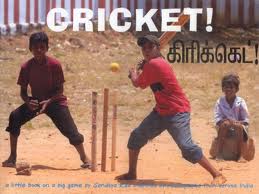
Cricket. Rao, Sandhya. Tulika Books, 2007. ISBN: 9788181463241.
Any time is time for cricket… Who wins? Who loses? Who cares? So long as the game goes on – anywhere, anyhow, and played by anyone. This little book of photographs, with just a line of text on each page, is a tribute to the universal and unifying spirit of cricket. Dual-language: English/Hindi.

A Day I Remember. Das, Prodeepta. Lincoln Children’s Books, 2014. ISBN: 9781847804464.
This book sheds light on the customs and traditions associated with Indian weddings through the story of Swayam, a young Indian boy whose uncle is getting married. Swayam has been chosen to be the markundi for his uncle’s wedding, or the male family member (usually a nephew or brother) who accompanies the groom to the bride’s house, dressed in special, ceremonial clothing. The boy narrates the events leading up to the wedding (the beating of drums, the sprinkling of holy water over the groom), as well as the event itself.
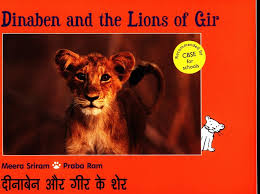
Dinaben and the Lions of Gir. Sriram, Meera & Ram, Praba. Translated by Krishnan, Priya. Tulika Books, 2010. ISBN: 9788181467614.
Dinaben is a Maldhari and her village is right in the middle of the Gir forest where the lions live. How does she live? What does she do? This book offers a glimpse into the many aspects of life in the forest through simple text and photographs. Children will find it easy to follow the story in two languages, English and Hindi. CD included.
Do! Wolf, Gita. Hengadi, Ramesh, Ill. Tara Books, 2009. ISBN: 9788190754613.
Do! is made of action pictures from the Warli style of tribal art of Western India. Traditionally it is the women of the Warli community who painted the walls of their homes. The art recorded important events in the village like the sowing, transplanting, and harvesting of rice. All the action happens on a single spread and the painting tells the entire story. This book can be used in many ways: as a picture book, to learn verbs, to talk about ancient village life, or using white chalk to draw pictures and stories in Warli style. The book’s illustrations are silk-screen, and the book was bound by hand.
The Elephant’s Friend and Other Tales from Ancient India. Williams, Marcia. Candlewick, 2014. ISBN: 9780763670559.
This graphic storybook collection of eight ancient Indian folktales were taken from the Hitopadesha, Jataka, and Panchantra Tales and retold humorously and in comic book style. Although there are no citations, Williams has retold the tales fairly accurately with beautiful and vivid illustrations.
Festival of Colors. Sehgal, Surishtha & Sehgal, Kabar. Harrison, Vashti, Ill. Beach Lane Books, 2018. ISBN: 9781481420495.
Spring is here, and it’s almost time for Holi, the Indian Festival of Colors. Siblings Mintoo and Chintoo are busy gathering flowers to make into colorful powders to toss during the festival. And when at last the big day comes, they gather with their friends, family, and neighbors for a vibrant celebration of fresh starts, friendship, forgiveness, and fun!
Ganesha’s Sweet Tooth. Patel, Sanjay & Haynes, Emily. Patel, Sanjay, Ill. Chronicle Books, 2012. ISBN: 9781452103624.
This is a funny picture book retelling (with a twist) of how Ganesha came to help write the epic poem of Hindu literature, the Mahabharata. Ganesha is just like any other kid, except that he has the head of an elephant and rides around on a magical mouse. And he loves sweets, especially the traditional dessert laddoo. But when Ganesha insists on biting into a super jumbo jawbreaker laddoo, his tusk breaks off! Ganesha is terribly upset, but with the help of the wise poet Vyasa, and his friend Mr. Mouse, he learns that what seems broken can actually be quite useful after all.
Going to School in India. Heydlauff, Lisa. Upadhye, Nitin, photographer. Charlesbridge, 2005. ISBN: 9781570916663.
Do you cross a rope bridge to get to school? Does your school meet in the middle of the desert? Does your school bus double as a classroom? If you lived in India, you might answer “yes!” In this inspiring book, meet students who overcome these and other challenges — all for the chance to learn. Captivating photographs, engaging text and a contemporary, innovative design open a window to this vibrant culture.
Grand Plan to Fix Everything. Krishnaswami, Uma. Halpin, Abigail, Ill. Antheneum, 2013. ISBN: 9781416995906.
Eleven-year old Dini loves movies—watching them, reading about them, trying to write her own—especially those oh-so-fabulous Bollywood movies where you don’t need to know the language to get what’s going on. But when her mother reveals some big news, it does not at all jive with the script Dini had in mind. Her family is moving to India for two years, and not even to Bombay, which is the “center of the film universe” (and home to Dini’s all-time most favorite star, Dolly Singh). No, they’re moving to a teeny, tiny town that she can’t even find on a map: Swapnagiri. It means Dream Mountain, a sleepy little place where nothing interesting can happen….
Grandfather Gandhi. Gandhi, Arun & Hegedus, Bethany. Turk, Evan, Ill. Atheneum, 2014. ISBN: 9781442423657.
Mahatma Gandhi’s grandson Arun tells the story of his grandfather’s teaching of peace and patience. As Arun visits his grandfather in Sevagram, his service village, Arun begins to feel resentment for having to share his grandfather with so many other people, and he struggles to learn Gujarati. He also feels anger towards another boy while playing soccer. This is a beautiful story reinforcing the notion of coping with internal anger through patience and peace.

Hanuman: Based on Valmiki’s Ramayana. Jendresen, Erik & Greene, Joshua M. Ming, Li, Ill. Trycicle Press, 2003. ISBN: 9781883672782.
This retelling of a portion of the ancient Indian epic, the Ramayana, takes the unusual perspective of Hanuman, military leader of the monkey clan. The tale opens when he is an impish young monkey, daring to fly to the sun. During his flight, he becomes distracted and falls, thus earning his name, which means “broken chin,” and the elder monkeys pray he forgets his magical powers. Years later, when the evil, 10-headed creature Ravana steals Rama’s beloved wife, Sita, the monkey is deeply moved by the young prince’s broken heart. His clan joins forces with Rama to confront Ravana. Now Hanuman must remember the incredible powers of his youth for they are crucial in the climactic battle.
I is for India. Das, Prodeepta. Lincoln Children’s Books, 2016. ISBN: 9781847807571.
From Bollywood to Peacock, from Namaskar to Tea, this photographic alphabet is a celebration of India in all its vast and colorful diversity. Prodeepta Das explores India’s customs, religions and culture, focusing both on the rhythms of the bustling cities, and on day-to-day village life. This stunningly photographed introduction to this unique and vibrant subcontinent shows images of today’s India.

India at the Olympic Games. Krishnan, Priya & Nayar, Deeya, Rao, Sandhya. Tulika, 2017. ISBN: 9789350461891.
This book provides an overview of India’s participation in the Olympic Games. India was first represented in the 1900 Summer Games in Paris, and made its debut in the Winter Olympics in 1964. Also included are anecdotes, timelines, and milestones of India’s continued Olympic participation from 1900 forward.
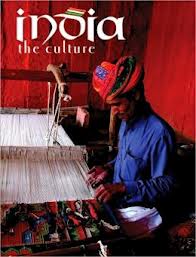
India: The Culture. Kalman, Bobbie. Crabtree, 2009. ISBN: 9780778796572.
This book is a concise yet thorough introduction to India’s religions, entertainment, clothing, cuisine, art, festivals and sports, with simple descriptive explanations and contemporary pictures. Kalman provides a useful glossary at the back. Although she is not Indian, she has provided factual non-biased information.
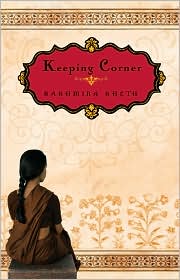
Keeping Corner. Sheth, Kashmira. Disney Hyperion, 2007. ISBN: 9780786838608.
This historical fiction text is set in India in the early 1900s during the time that Gandhi was leading non-violent protests against the caste system and the British colonists. Leela, the main character is a child-bride who is widowed at the age of 11. Tradition states that since she’s a certain caste, she must keep corner for a year, which involves staying home, shaving off her hair ,and wearing a mourning sari. Her story exposes enormous gender inequalities and social pressures during the time period. Sheth’s book authentically illustrates what living in Gujarat, India during the early 1900’s would have been like. She was inspired to write the story by her great-aunt who was also a widow in Gujarat.
Monsoon. Krishnaswami, Uma. Akib, Jamel, Ill. Farrar Straus and Giroux, 2003. ISBN: 9780374350154.
Children play, birds call, and adults go about their business during the hot days of summer in northern India. But in the bustle of the streets and marketplaces, everyone is watching, waiting for those magical clouds to bring the gift of rain to the land. Through the observations of one young girl, the scents and sounds, the dazzling colors, and the breathless anticipation of a parched cityscape, are vividly evoked during the final days before the welcome arrival of the monsoon.
My Dadima wears a Sari. Sheth, Kashmira. Yoshiko, Jaeggi, Ill. Peachtree, 2007. ISBN: 9781561453924.
The story set in America, is about Rupa and her dadima (paternal grandmother). Rupa asks her dadima if she ever feels like wearing a dress, and dadima explains to Rupa about all the wonderful things she can do with a sari – from becoming an umbrella in a rainstorm to providing a deep pouch to carry seashells collected from the beach. This is a beautiful story of the bond between a child and her grandparent. A note from the author and instructions for wrapping a sari are included.
My First Book of Hindi Words: An ABC Rhyming Book of Hindi Language and Indian Culture. Singh, Rina. Zaman, Farida, Ill. Tuttle, 2016. ISBN: 9780804845625.
Organized as an ABC rhyming book, the text incorporates common Hindi words into charming English language rhymes. An illustration of each word enables readers to make their first venture into India’s official language. A helpful glossary makes it easy for readers to review what they have learned.
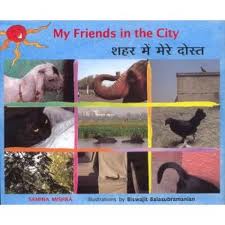
My Friends in the City. Mishra, Samina. Balasubramaniam, Biswajit, Ill. Tulika, 2007. ISBN: 9788181462114.
Who says the city belongs only to people? Meet Moti the elephant, Phad Phad the pigeon, Banno the buffalo, and many other two and four-legged creatures also living in the city. Photographs and cheerful illustrations combine with easy text to give children a fresh perspective to more everyday birds and animals. CD included.

One, Two, Tree! Ravishankar, Anushka & Rao, Sirish. Bai, Durga, Ill. Tara Books, 2014. ISBN: 9789383145096.
This delightful book encourages active participation and close observation. As the number of animals in a tree increases from 1 dizzy ant to 10 hefty elephants, children are encouraged to spot and count them. One spread clearly identifies the number, the word, and corresponding animals. This book also introduces the traditional Gond art form.
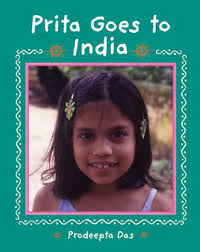
Prita Goes to India. Das, Prodeepta. Francis Lincoln Books, 2006. ISBN: 9781845071288.
Seven year-old Prita has come to India for the first time, with her parents and her elder sister, to visit their many relatives. She is fascinated by everything from the Taj Mahal, to the village shrines in Orissa, where her parents were born; from delicious green coconuts, to market stalls filled with savory snacks; but above all, by the way of the daily life of her relatives. Some of it is like her life at home — but much of it is very different. India and Prita, come alive in this book that offers a child’s-eye-view of another country and culture.
Rangoli. Ananth, Anuradha. Jain, Shailja, Ill. Frances Lincoln Books, 2011. ISBN: 9781847801791.
Every morning Ajji’s village is decorated with rangolis – special patterns made usually from rice flour and sugar or cereals, grains, sand or beads. Dots, lines, flower designs, on the ground on the wall, everywhere. Food for ants, beautiful to look at and fun for birds, dogs and children. This delightful book is an introduction to the art of rangoli, and includes a spread at the back on how to design and make rangolis.

Rangoli: An Indian Art Activity Book. O’Farrell, Suma. Mazza, 2012. ISBN: 9780984962402.
This drawing book introduces the art form from India called rangoli. It offers a variety of designs with easy-to-follow colored lines to help beginners learn this technique, and explore the possibilities of using the grids. There are over 100 pages of designs and grids for making rangolis including geomantic shapes, mazes, optical illusions, 3D images, and more.
Rikki-Tikki-Tavi. Kipling, Rudyard. Pinkney, Jerry, Ill. HarperCollins, 1997. ISBN: 9780688143206.
This timeless story is of Rikki, a fearless young mongoose who finds himself locked in a life-and-death struggle to protect a boy and his parents from Nag and Nagaina, the two enormous cobras who stalk the gardens outside the family’s home in India. This retelling reflects Kipling’s stereotypes and the British colonial perspective of India.
Sacred River. Lewin, Ted. Clarion Books, 1995. ISBN: 9780395698464.
All rivers in India are sacred, and the Ganges most of all. Every year, more than one million Hindu pilgrims journey to Benares to renew themselves in its waters. Caldecott Honor medalist Ted Lewin joined the pilgrims at the river’s edge for an experience he describes as one of the most unforgettable of his life. His luminous watercolors and simple, evocative text brilliantly capture the traditions, beliefs, and colorful pageantry of the devout and their ancient city.
Secret Kingdom: Nek Chand, A Changing India, and a Hidden World of Art. Rosenstock, Barb. Nivola, Claire, Ill. Candlewick, 2018. ISBN: 9780763674755.
After the partition of India in 1947, Nek Chand Saini settled in the city of Chandigarh. Dismayed at his stark new surroundings, Nek began collecting river rocks, broken glass, and cracked water pots found on the roadside. He cleared a section of jungle and for seven years he stockpiled odds and ends. He began to build a labyrinth of curving paths, mosaics, and repeating patterns: his very own tribute to the winding village of his youth, a hidden land of stories. Nek kept his kingdom secret for fifteen years, until a government crew stumbled upon it and sought to destroy it. But local fans agreed in awe: the Rock Garden had to be protected.
Sita’s Ramayana. Arni, Samhita. Chitrakar, Moyna, Ill. Groundwood Books, 2011. ISBN: 9781554981458.
The Ramayana saga dramatically chronicles the struggles of Queen Sita. Numerous plot turns, magical animals, sorcery, gods, and demons create drama. This visually stunning graphic novel, told from Sita’s perspective, uses drawings from traditional Hindu pictographs and cave paintings.
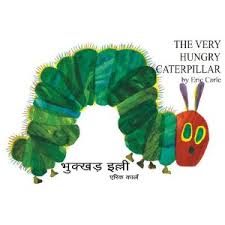
The Very Hungry Caterpillar. Carle, Eric. Karadi Tales Company, 2008. ISBN: 9788181901309.
This is the traditional story of The Very Hungry Caterpillar that tells readers about the life of a caterpillar from egg to butterfly. This book teaches first words in Hindi in a story format that teaches the days of the week, numbers and counting, and names of some foods. Dual-Language: English and Hindi. Translated by Sushma Bakshi
What Should I Make? Nayar, Nandini. Roy, Proiti, Ill. Tricycle Press, 2009. ISBN: 9781582462943.
Neeraj’s mother is making chapatis and gives him a handful of the dough. What should he make with it? A snake? A mouse? A cat? But what if his creations come to life? “Roll it up, quick!” says his mother. Roll it, he does, and makes a big round chapatti… hot, light, and puffy after it’s cooked, and perfect for snacking.

Hi Editors- your wonderful and expansive book list was recently called to my attention. Noticed that you do not list my book, Indi-Alphabet available widely in the USA. Here’s the link to the publisher https://bharatbabies.com/products/indi-alphabet
I have written other books that should be part of your list, including http://english.dcbooks.com/the-autobiography-of-a-tree-3.html
PLease do get in touch if you have questions.